Please Take Note: This is a review of the final game, but it might change slightly based on the success of the Kickstarter campaign. The game is being reviewed on the components and the rules provided with the understanding that “what you see is not what you might get” when the game is published. If you like what you read and want to learn more, we encourage you to visit the game publisher’s website or visit the Kickstarter campaign. Now that we have all that disclaimer junk out of the way, on with the review.
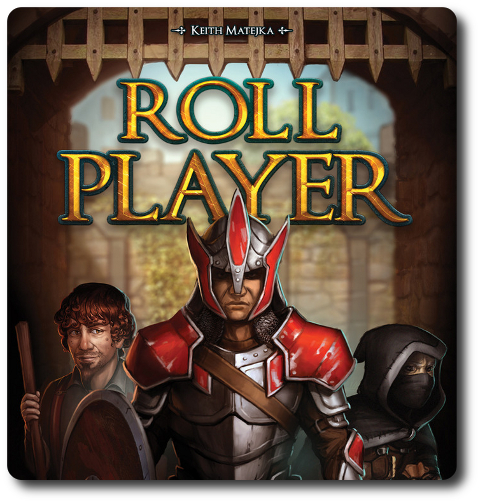
The Basics:
- For ages 8 and up (publisher suggests 10+)
- For 2 to 4 players
- Approximately 60 minutes to complete
Geek Skills:
- Counting & Math
- Logical & Critical Decision Making
- Reading
- Pattern/Color Matching
- Strategy & Tactics
- Hand/Resource Management
Learning Curve:
- Child – Easy
- Adult – Easy
Theme & Narrative:
- Build up your character by building up your character
Endorsements:
- Gamer Geek approved!
- Parent Geek mixed!
- Child Geek rejected!
Overview
I remember spending hours tinkering on my Dungeons & Dragons character. Researching abilities, calculating stat scores, and attempting to determine the best armor sets. It was all about pushing the limits to succeed. In this game, players will be attempting the same thing, as they take their fantasy hero to new epic levels of attribute domination!
Roll Player, designed by Keith Matejka and to be published by Thunderworks Games, will reportedly be comprised of 4 Character Sheet boards (double-sided), 73 standard six-sided dice (10 green, 10 blue, 10 purple, 10 black, 10 white, and 10 yellow), 1 dice bag, 4 Player Aid/Reputation Track cards, 6 Class cards, 12 Backstory cards, 13 Alignment cards, 48 Market cards, 5 Initiative cards, 55 Gold tokens, 12 Tracking tokens (2 in each Class color for a total of 12), and 4 Charisma tokens. As this is a review of a prepublished game, I cannot comment on the game component quality. Artists John Ariosa and Luis Francisco contributed some fantastic illustration for the Character Sheet boards and the Market cards, giving players an intriguing visual glimpse into the fantasy world they are playing in.
Preparing for Adventure!
To set up the game, first have each player roll 1 of the dice. The player who rolls the highest is the Starting Player. The Starting Player places all the dice in the dice bag.
Second, beginning with the Starting Player and continuing in turn order sequence around the table, each player selects 1 Character Sheet board. The Character Sheet boards are double-sided, depicting the same Race, but different genders. Gender plays no role in the game other than player’s preference. The Character Sheet board is placed in front of the player. Place all Character Sheet boards not selected back in the game box.
Third, beginning with the Starting Player and continuing in turn order sequence around the table, each player draws 1 die from the dice bag without looking. The color drawn corresponds to a Class card. For example, the white dice corresponds to the “Cleric/Paladin” Class card. Each Class card is double-sided, depicting a different class. The player reviews both sides of the Class card and places it on their Character Sheet board with their preferred side face-up. If the player draws a color already selected or a yellow die, they draw again and continue to draw until a color is drawn that is not selected. Alternatively, players can just select the Class they want. Place all Class cards not selected back in the game box.
Fourth, shuffle the Backstory and Alignment cards, creating 2 decks of cards. Deal 1 Backstory and 1 Alignment card to each player. These are placed on the player’s Character Sheet board. Hand to each player a Player Aid/Reputation Track card at this time, as well. This card can go anywhere next to the player. Then give each player 2 Tracking tokens of the same color that match the color of their Class color. One token is placed on the colored gem on their Class card and the other is placed in the center position on their Alignment card. Place all Tracking tokens, Backstory, Alignment, and Player Aid/Reputation Track cards not used back in the game box.
Fifth, take the Market cards and organize them so there are 2 piles of Market cards. One pile will contain Market cards that have a single-dot and the other pile will contain Market cards with a double-dot. Shuffle both piles separately and then place the single-dot Market cards on top of the double-dot Market cards to create the Market draw deck. Now deal face-up to the middle of the playing area a row of Market cards. There will be 1 Market card per player, plus 1 more Market card. For example, a 3 player game will have 4 Market cards. Place the Market deck face-down on one end of the Market card row.
Sixth, place the Initiative cards above the Market cards in a row, starting with “1” Initiative card, then “2” Initiative card and so on until the number of Initiative cards is equal to the number of face-up Market cards. Place any Initiative cards not used back in the game box.
Seventh, place the Gold tokens next to the Market cards in a pile. This is the Gold supply. Place 1 Gold token on each of the Initiative cards, except the first (which would be number “1”) and the last in the order sequence. For example, if the Initiative cards were “1, 2, 3, 4, and 5”, Initiative cards “1” and “5” would not be given a Gold token.
Eighth, beginning with the Starting Player and continuing in turn order sequence around the table, each player draws 1 die per player, plus 4 more. For example, in a 3 player game, each player would draw 7 dice. After they are drawn, the player rolls each and places any but the yellow colored die in 1 of the 6 Character Sheet board “Attribute” slots, but only in the left-most position of each Attribute row and only 1 per row. The number value indicates that particular Attribute value. No Attribute actions are taken at this time. For each yellow die drawn, the player collects 1 Gold token, unless the player has a Class or Background card that says otherwise.
That’s it or game set up. Time to have an adventure!
The Anatomy of Your Hero
Roll Player focuses primarily around the player’s Character Sheet board. This is where the player will be recording their progress, improving their chances of winning, and can tell at a glance what their current standing is among their peers. The Character Sheet board will either hold or have attached to it everything the player currently has available to them.
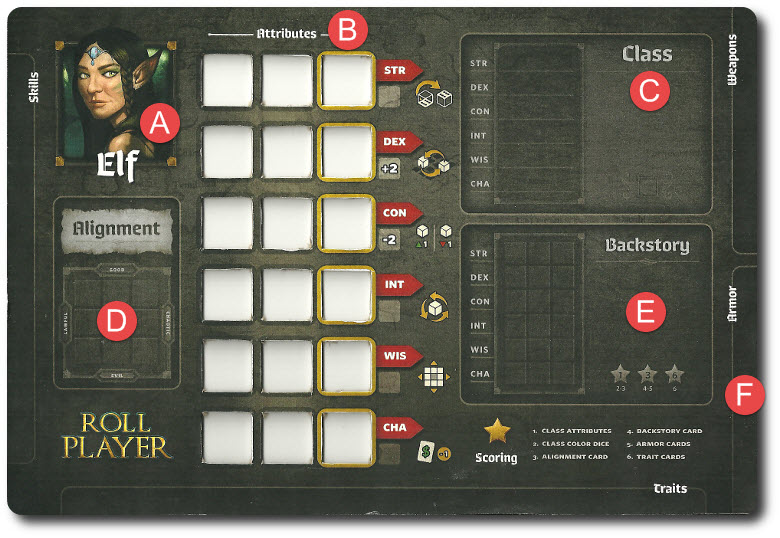
A) Character Race
Each Race has a male and female gender side. While gender has no impact in the game (a woman can kick butt just as well as a man, folks), the selected Race will impact the overall final Attribute scores. This is not a bad thing, but it’s something the player will need to be aware of while playing so they can leverage their selected Race to maximize their final score at the end of the game.
B) Character Attributes
Each character has 6 Attribute values. These are Strength, Dexterity, Constitution, Intelligence, Wisdom, and Charisma. There a total of 3 dice slots per Attribute row, some of which will contain a die during game set up. Additional dice will be added, increasing the character’s overall Attribute values, which is scored at the end of the game. Some Races have an Attribute bonus or penalty that will alter the player’s final score for that particular Attribute.
Each Attribute row triggers an Attribute action that takes place when a player adds a die to an empty slot in an Attribute row. Each Attribute action can only by taken a maximum of 3 times since only a total of 3 dice can be added to each Attribute row. The Attribute actions are as follows:
- Strength: Change any die on the Character Sheet board to its opposite side.
- Dexterity: Swap the position of any 2 dice on the Character Sheet board without changing their current value.
- Constitution: Increase or decrease the value of any 1 die on the Character Sheet board (minimum value is 1, maximum value is 6).
- Intelligence: Reroll any 1 die on the Character Sheet board and either keep the new value or continue to use the old value.
- Wisdom: Move the Tracking token on the Alignment card 1 space up, down, left, or right.
- Charisma: Collect 1 Charisma token.
C) Class Card
The Class card defines the profession of the character. Each side of the Class card has a unique adventuring profession, with their own pros and cons, although no single Class card is better than another. Listed on each Class card are the Attribute Goals. This lists the Attribute scores and the value range the player should attempt to achieve if they want to earn additional Reputation points. The color of the Class card is also important, as some Class cards will be awarded additional Reputation points at the end of the game. Finally, the listed Class ability is unique to the player and can be used by the player when it’s most appropriate.
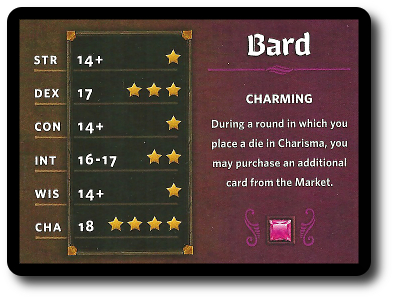
D) Alignment Card
Each Alignment card has a title that thematically captures the values of the Alignment. Game wise, the Alignment card is used as a grid that allows the player to slide a Tracking token around during the game, which thematically represents the shifting values of the character within the defined limits of the Alignment card. As the game progresses, the character’s alignment will shift from Neutral (the starting position) to good or evil, lawful or chaotic. Points are earned at the end of the game based on the Tracking token’s position in the grid.
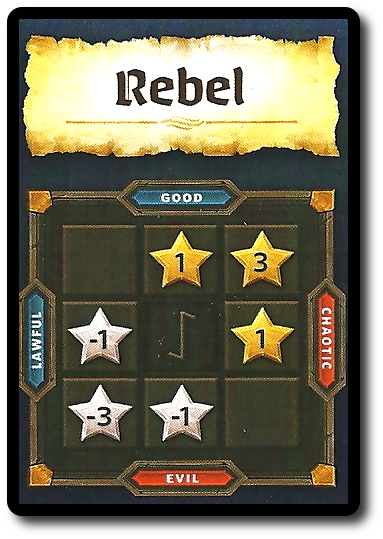
Image is larger than actual card in order to show grid
E) Backstory Card
The Backstory card provides a brief summary of where the character has been and what they have been up to until this very moment. Thematically interesting, but it has no impact on the game play. What does impact the game play is the Backstory grid that displays the Attributes and a specific die color in a specific column and row. If the player can match what is shown on their Backstory card, they will earn additional Reputation points at the end of the game.
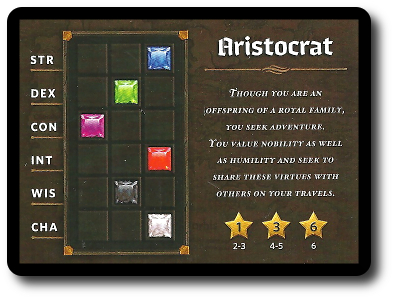
F) Organization Areas
Surrounding the Character Sheet board are organization areas for “Skill”, “Weapon”, “Armor”, and “Trait” Market cards. Players place these cards in these areas to help keep their playing area organized.
Let’s Roll Play
Roll Player is played in rounds with no set number of rounds per game. Each player’s turn during the round is divided into 4 sequential phases. A single round of game play is summarized here. A round always begins with the Starting Player.
Phase 1: Roll Dice Pool
The Starting player draws 1 die per Initiative card in play and rolls them. This is the dice pool for the round. The lowest valued die is placed on the “1” Initiative card, followed by the second lowest valued die being placed on the “2” Initiative card and so on until each Initiative card has a die.
Phase 2: Select Die and Initiative
Beginning with the Starting player, each player selects 1 Initiative card, taking the die and any Gold coins on it. The die value is not changed and it’s immediately placed on any open slot on the player’s Character Sheet board in the left-most position. When the die is placed, it will trigger an Attribute action, which is also immediately taken, but only if the player wants to take it. If the die is placed in the last position of the row, filling it entirely with dice, the player collects 1 Gold coin. If a yellow die is taken, the player collects 2 Gold coins.
One Initiative card will always remain in the middle of the playing area.
Phase 3: Visit the Market
Starting with Initiative card value of “1”, and then “2” and so on, each player can now visit the Market and purchase any of the face-up Market cards. The cost of each Market card is listed in the upper right hand corner which indicates how much Gold must be placed back in the supply to claim the Market card. Acquired cards are immediately placed in the appropriate organization area around the Character Sheet board. When a Market card is taken, it’s NOT replaced with a new one. This means that the last player to visit the Market will have significantly fewer Market cards to select from.
If the player has collected any Charisma tokens, they can be used in the Market to reduce the price of the Market card. The player can use them or not, depending on their goals, but they will lose any Charisma tokens at the end of the round.
There is no limit to the number of “Trait”, “Skill”, or “Armor” Market cards the player can purchase and use.
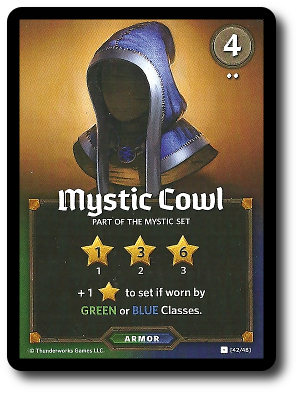
“Weapon” Market cards, however, will come in single and double-handed varieties. A player cannot equip any more “Weapon” Market cards than they have free hands. This means the player can have either 2 singled-handed “Weapon” Market cards or 1 double-handed “Weapon” Market card. The player can always replace their current “Weapon” Market card by placing the one they do not need to the Market discard pile.
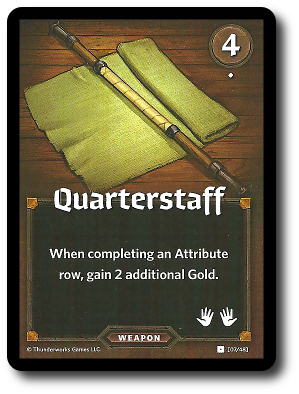
“Trait” and “Skill” Market cards are active the moment they are purchased. “Trait” Market cards force the player to move their Tracking token on their Alignment card.
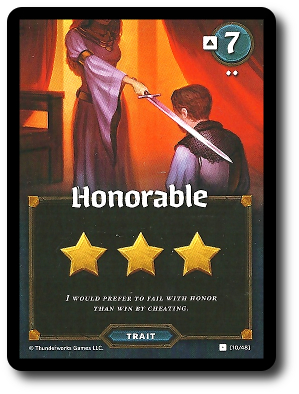
“Skill” Market cards can be activated to move the Tracking token when the player wants to and then they can perform the listed action. Doing so, however, exhausts the “Skill” Market card for the duration of the round.
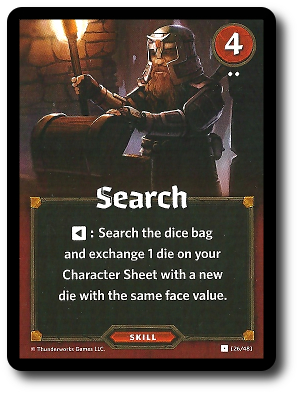
After a player is done purchasing a Market card or if they pass, they place their Initiative card back to the middle of the playing area.
Phase 4: Clean Up
A few steps are taken to end the round and prepare the players for the next round of game play.
- All collected Charisma tokens are returned to the Charisma supply.
- Each player may refresh 1 exhausted “Skill” Market card.
- Any remaining die in the dice pool and on any Initiative cards are placed back into the dice bag.
- New Market cards are drawn to fill in the gaps from those that were purchased.
- The Initiative cards are correctly ordered and Gold tokens are placed where appropriate (an Initiative card will never have more than 1 Gold token on it).
- The Starting Player passes the dice bag to the player on their left. This player is now the new Starting player.
This ends the round and a new round now begins.
Ending the Adventure
The game ends after phase 3 of a round when all players have completely filled their Attribute rows and columns with dice. Each player’s score is now calculated. The Player Aid/Reputation Track cards are now flipped over so the side with the stars showing. Each player takes their token placed on their Class card and sets it next to the Player Aid/Reputation Track card. It will be used to help the players keep track of their scores.
Scores are counted in the following order.
- Attribute Goals: If the player was able to fulfill the goal set by their Class card, they receive points. Each of the 6 Attributes is reviewed in order. The EXACT number must be met if only 1 value is provided. If a range is provide, the player will score points if their currently total dice for the Attribute in question falls within that range. Some goals list a plus (+) sign. This indicates the total Attribute value must be higher than the value listed on the Class card. Be sure to take into account the Race Attribute bonuses and penalties when calculating values.
- Class Color: Each die the player has that matches the color of their Class card earns the player 1 additional Reputation point.
- Alignment: The current bonus or penalty star value indicated by the Tracking token on the Alignment card is now resolved.
- Backstory: If the player was able to match the die position and color indicated on their Backstory card, they will earn a number of points determined by the total number of die in the right position.
- Armor: Any Reputation points provided by “Armor” Market cards are now determined and scored. Some “Armor” Market cards award more Reputation points based on the number included in a set.
- Traits: Any Reputation points provided by “Trait” Market cards are now determined and scored.
After the players have calculated and recorded all their Reputation points, the player with the most points wins the game.
To learn more about Roll Player, visit the game publisher’s website or visit the Kickstarter campaign.
Final Word
The Child Geeks were very excited to play this game, but were immediately disillusioned when they learned they would not be fighting any monsters or going on any quests. According to one Child Geek, “What is the point of playing a fantasy game with heroes if you can’t do anything heroic?” After learning the game, the older Child Geeks who had also played Role-Playing games enjoyed themselves, but all the other Child Geeks did not. As one Child Geek put it, “The game is OK, but it’s just not very exciting or interesting. I don’t feel like I’m really doing anything.” To which an older Child Geek responded, “Yeah, I know what they mean. This game is all about building a really big character, but you never get to do anything with them.” In the end, only a few of the older Child Geeks gave Roll Player their approval, mostly because they enjoyed playing board games and Role-playing games where micromanagement was required. Everyone else gave it a pass.
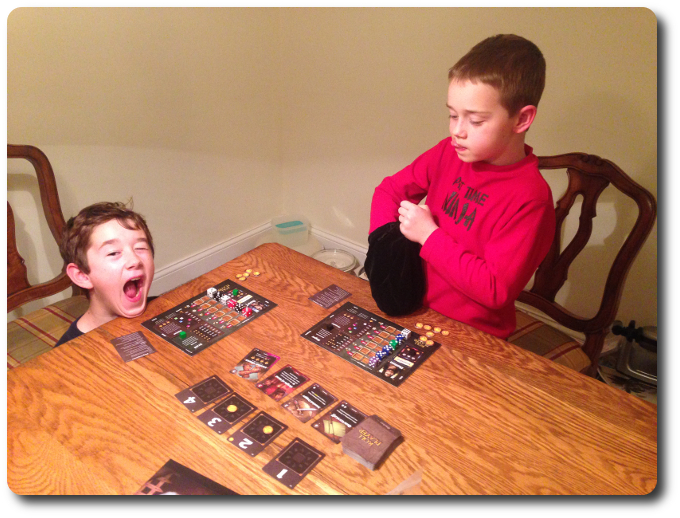
Time to draw the dice! My oldest son thinks his brother is a horrible “random” drawer…
The Parent Geeks had mixed feelings, as well. The vast majority believed that Roll Player was going to have some sort of fantasy element to it that required them to do something with their characters. When they learned that the game was fully focused on improving the character’s states only, there were a lot of frowns and raised eyebrows. According to one Parent Geek, “So, this game is just about making a super fantasy character by going to the training grounds constantly? I’ll buy that, but for what purpose?” When I told them that the goal was to earn the most points by completing a number of Attribute builds, a number of the Parent Geek grew interested, while others grew even more disinterested. After several games, the Parent Geeks were ready to vote. According to one Parent Geek who did not care for the game, “I didn’t like it because all you do it just count points over and over again on your character. You never really do anything.” But a Parent Geek who did enjoy it said, “This is the perfect blend of fantasy and resource management. I really enjoyed it. I felt like I was designing the most perfect hero I could and that was really challenging. Two thumbs up from me!” The final vote resulted in the Parent Geeks giving the game a mixed level of approval.
The Gamer Geeks were very pleased that they were not going to go save dragons or slay maidens, finding that whole “adventure thing” to be overplayed. Instead, they were very intrigued at the game’s concept and how it would work. According to one Gamer Geek, “I’m curious to see how this plays out. It’s designed off of Role-Playing games that have all these bonuses and penalties to impact dice outcomes that determine results. In this game, there is no action, so what are weapons and armor used for?” When the Gamer Geeks found out, they very much enjoyed themselves. As one Gamer Geek put it, “This is a highly thematic game that really has no story whatsoever. If feels a bit weird, as if we missed the adventure portion of the game, but everything is really working well.” Another Gamer Geek said, “A very challenging game that requires the player to think on multiple levels and take different actions in hopes of altering several outcomes. I’m most pleased by its presentation and uniqueness.” When all the adventurers retired, the Gamer Geeks voted to approve Roll Player.
This game suffered from assumptions, which I don’t believe it could have avoided. Everything in the game, from names of cards to names of Attributes is a nod to traditional Role-Playing games. Anyone who has heard of or has played such games knows they are full of twists, turns, and a lot of narrative. Roll Player has none of this and falls flat for those who assumed such things from the game. This put a bad taste in many mouths during our playing sessions that I was never able to rinse out. As such, I believe that some of the negativity towards the game is based more on disappointment rather than game play, as the game plays perfectly fine. It just wasn’t a game people wanted to play.
I very much enjoyed the Roll Player, finding it to be a fun exercise in set collecting and managing said sets once I collected them. At no time did I ever feel the game was particularly challenging, but this did not reduce my overall level of interest. This is not a game you play because you want to test out the hero’s skills, as there is nothing to test them on. Instead, you play this game because you enjoy tweaking, twisting, altering, and shaping based on predefined goals and new objectives.
But let’s acknowledge the elephant in the room here. The game is highly thematic and that’s where it threw many off track. There is no supporting narrative for what the players believe they are doing, which is creating a hero that will go and do something. Again, it’s not that kind of game. I wouldn’t go so far as to say the game’s theme is pasted on, because everything works so wonderfully well together, but this game could have been easily re-themed as managing a space colony or building a town in Nebraska. It just so happens that the theme is about building a fantasy hero and it works. The only glitch is that most of the time you would expect to do something with the hero you are creating. Which you don’t.
What we have here is a game that is trying something new and that can sometimes be too radical for some. Roll Player is a good example of taking one small (but important) part of one game and making it the entire focus of another. It brings with it a lot of the original game’s mystique that unfortunately has no place in the new design. For those looking for a game with high fantasy and adventure, Roll Player is going to leave you severely disappointed. For those looking for an adventure of a different kind, where your mind must quest for the perfect method of boosting scores, you must properly equip your hero to score points on multiple levels, and the danger of reaching too far too early is always present, then Roll Player will certainly be an adventure you will want to take.
This is a paid for review of the game’s final prototype. Although our time and focus was financially compensated, our words are our own. We’d need at least 10 million dollars before we started saying what other people wanted. Such is the statuesque and legendary integrity of Father Geek which cannot be bought except by those who own their own private islands and small countries.




That’s what turned me off from the game — you don’t do anything with them. I think it could have easily benefited from a Galaxy Trucker type of event deck for each of the characters to face-off against. Would have been an insta-buy for me if it had something like that.
That was the general assessment from our groups, as well, Nate. A lot of very interesting build up and focus with no real payoff. However, the majority of Gamer Geeks liked the challenge of the character building aspect, finding the payoff to be the endgame and the collection of points. I still believe that this game suffers from assumptions by the player, and as such, it never lives up to certain expectations. The real shame of it is that the game itself never promised anything more than what it is. It’s like being disappointed that the mailman isn’t also Superman.
Nice!